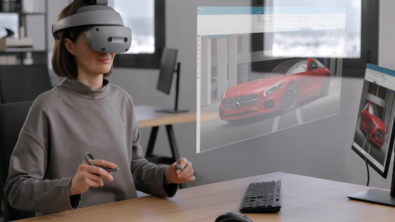Going beyond automation with the Industrial Copilot – Part 1 Transcript

Automation is a powerful tool and AI can take it a step further. Find out how AI is going beyond automation in the Industrial Copilot by checking out this podcast episode or reading along to the transcript below.
Spencer Acain:
Hello and welcome to the AI Spectrum podcast. I’m your host, Spencer Acain. In this series, we explore a wide range of AI topics from all across Siemens and how they apply to different technologies. Today I am joined by Michi Lebacher, Head of AI and Digital Business at Siemens and Alessia Bortolotti, customer discovery manager at Siemens AG, to discuss the applications of AI in the industrial co-pilot.
Alessia Bortolotti:
Thank you. Hi.
Michi Lebacher:
Hi. Nice to be here.
Spencer Acain:
Glad to have you both. So before we jump into our main topic here, can the two of you give me some brief background on yourselves and your work at Siemens? And I think let’s start with Michi with this one.
Michi Lebacher:
Yes. Sure, sure. Yes, I’m with Siemens. Now this is a typical Siemens thing that you start with, how long you’re with Siemens, now for or five years. The way I made through Siemens was starting at the corporate technology department where I started as an AI researcher where I did applied work as well as theoretical work. And then I found my way from being a researcher in AI to a more applied place in the pre-development department of the IFA, so factory automation. And there I had the group, which as you already outlined, is for pre-development, industrial AI and digital businesses. And our goal is to find in the space of factory automation, new opportunities for Siemens where we utilize both digitalization and AI to bring value to our customers.
Spencer Acain:
Fascinating. And Alyssa, what about you?
Alessia Bortolotti:
Sure. So I’m Alessia Bortolotti. I started working at Siemens in December 2022, as customer discovery manager. So I work in the team of Michi. Regarding my background, I would say it’s very diverse. It goes from market intelligence to IT consultancy and field of process optimization, data analytics and machine learning. What I do now at Siemens is investigating, evaluating how to better tailor innovations to customer’s needs and their pains. And yeah, my main focus I would say is really on industrial AI projects. So AI applications in the discrete manufacturing.
Spencer Acain:
That sounds great. Both of you have some diverse backgrounds and some great experiences at Siemens. I think it’s time we get into our main topic here. So can you, Alyssa, explain what the industrial co-pilot is and what its applications of AI are?
Alessia Bortolotti :
Sure. So before I start explaining that in detail, when we talk about industrial co-pilot are actually meaning umbrella terms. We have, in fact, developed some different kind multiple type of industrial co-pilots. In fact, we are developing five kind of co-pilots along the industrial value chain. So we investigated some opportunities there and this phases where we found some benefits for the customers are design, then planning, engineering, operating, and then service.
For some of them we have already some products, but I would say that in general we are really at the beginning, in the early stage of a journey of this generative AI technology. Talking about really what is an industrial co-pilot. So I would say is a generative AI based tool that can assist companies and employees by supporting them in different kind of tasks. By feeding the co-pilot with the right data, then these employees can then communicate with the co-pilot in an everyday language as if it were really another colleague. The co-pilot can also provide them answers fitting to the right context because it’s based on this knowledge base on the data and can give some recommendations and how to solve some specific tasks and can give also some best practices on how to solve or optimize some processes. I don’t know Michi if you want to add something here?
Michi Lebacher:
I mean that was well described. I mean like the question was what’s the industrial co-pilot? It turns out that actually we have multiple co-pilots. I think the one thing that I want to highlight, although you already made it quite clear, so this is a strategy perspective from Siemens, right? We say we take this topic serious and we want to go from something to play around with. Everyone knows Chat Gpt, everyone plays with it to something that translates that an actual customer value all along the value chain. So this is the idea that we have here, not so much coming only from the technology push side and saying, “Okay, there’s technology, what can we do with it?” But rather we say, “Okay, there are anyhow problems that our customers have and now we have better tools to address them.” This is the thing that I like so much about this co-pilot along the value chain that we start with the customer problems instead of the technology. That’s everything I wanted to add here.
Spencer Acain:
Great. Well, it sounds like the industrial co-pilot is a very broad topic then. It covers quite a bit and maybe it’s not quite so simple as just a short name might then imply. So can you give me some more information or maybe some examples of the different areas, industrial co-pilots being applied to and how AI is helping in those areas?
Alessia Bortolotti :
Sure. Maybe I can also start here. As I already mentioned, there are this main implementation areas that we are investigating and where we see really a benefit for the customers. Here maybe I can start with the first co-pilot, which is the industrial co-pilot for design. Here the idea is that a co-pilot can create mechanical design concepts by really leveraging different capabilities of design tools. These design tools are becoming more and more complex because they do not only address maybe one machine, but our whole production lines, whole factories. So with the co-pilot for design, this complexity can be really reduced and this technology can also accelerate the development of, for example, initial prototypes and mock-ups and also then help to generate new design variations.
The next co-pilot is the industrial co-pilot for planning. Here the idea is to optimize simulation and also the planning of different resources like for example, materials, time, and people. Can also generate different planning scenarios, also can provide some information about potential risks and optimal strategies or how to reduce these risks.
The next co-pilot, the next phase where a co-pilot can be helpful is the engineering phase. So the industrial co-pilot for engineering. Here, the target users are more automation engineers or software developers. They can then interact with the co-pilot to easily and quickly generate, optimize, debug, and document PLC code. So instead of spending a lot of time going through or writing hundreds of lines of code, they can then really focus on other kind of tasks that maybe are more really can be targeted by them as experts.
The next co-pilot is the co-pilot for operations. This is also the kind of co-pilot where Michi and I are working on. Here the main user is an operator or maintenance engineer. Here the co-pilot can support them to identify and solve issues in our machinery equipment. The co-pilot can access machine documentation, like for example, form of PDF or manuals, safety instructions, etc, but also can access, process, or sensor data. So it allows the co-pilot to provide real-time information about the status of a machine. With this information then the operators can get some suggestions on how to solve some issues or to reduce the downtime as well as also how to optimize, maximize the uptime.
The last co-pilot is the industrial co-pilot for service. Here at Siemens, we have already a predictive maintenance tool. It’s called Sensei. So Siemens thought about then integrating it with the co-pilot. This co-pilot for service then can facilitate assets intelligence across the plans without needing any manual analysis. It can also give automated service instructions and recommendations to really provide maintenance upgrades and additional services related to the factory. So overall, I would say that these co-pilots, what they have in common, is that they will allow the user to spend less time in completing this redundant or time-consuming task. Like for example, going over tons of pages of documentation of a machine to find a solution for a specific failure, but instead they can focus on really elements or those tasks that only human can do. So I would say here is a overview of the co-pilots that we have right now at Siemens.
Michi Lebacher:
Yeah. It became clear from what you said, right? That huge topic where we consider a lot of things. What I especially like is that we do this cross-border, so to say, of different business units. So one might think from the outside world, okay, Siemens is huge and certainly everything is siloed, but this is exactly the thing that we don’t have here. So kind of the whole value chain spans many different areas of Siemens and we need that because there are different expertises when it comes to planning and simulation tools. You need different terms of expertise than for the engineering copilot. The very nice thing is this connects all of us and we can leverage both the synergies that you have among different AI tools because there are some commonalities, but on the other hand, everyone can bring in his own expertise and it still forms a consistent value chain. So this is something I really love about it, that it’s also kind of like a cross-business unit venture that we do here together.
Spencer Acain:
It sounds like you’re really developing this whole ecosystem here and integrating AI across every level of the products that Siemens offers from top to bottom. And I think that is a great note to end the episode on. So I’d like to thank both of my guests here today. And once again, I have been your host, Spencer Acain on the AI Spectrum podcast. Tune in again next time when we continue delving into this interesting topic of the industrial copilot.
Siemens Digital Industries Software helps organizations of all sizes digitally transform using software, hardware and services from the Siemens Xcelerator business platform. Siemens’ software and the comprehensive digital twin enable companies to optimize their design, engineering and manufacturing processes to turn today’s ideas into the sustainable products of the future. From chips to entire systems, from product to process, across all industries. Siemens Digital Industries Software – Accelerating transformation.


